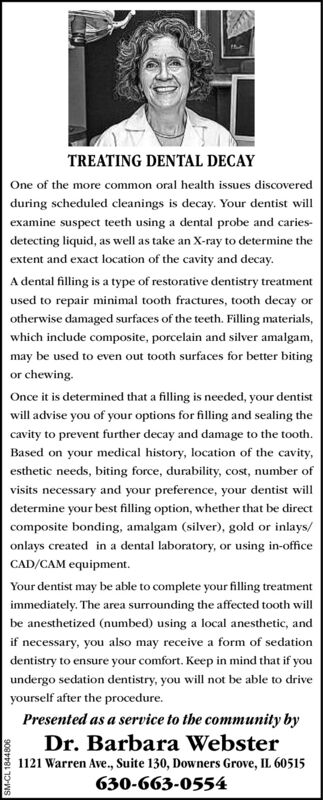Advertisement

-
Published Date
January 6, 2021This ad was originally published on this date and may contain an offer that is no longer valid. To learn more about this business and its most recent offers, click here.
Ad Text
TREATING DENTAL DECAY One of the more common oral health issues discovered during scheduled cleanings is decay. Your dentist will examine suspect teeth using a dental probe and caries- detecting liquid, as well as take an X-ray to determine the extent and exact location of the cavity and decay. A dental filling is a type of restorative dentistry treatment used to repair minimal tooth fractures, tooth decay or otherwise damaged surfaces of the teeth. Filling materials, which include composite, porcelain and silver amalgam, may be used to even out tooth surfaces for better biting or chewing. Once it is determined that a filling is needed, your dentist will advise you of your options for filling and sealing the cavity to prevent further decay and damage to the tooth. Based on your medical history, location of the cavity, esthetic needs, biting force, durability, cost, number of visits necessary and your preference, your dentist will determine your best filling option, whether that be direct composite bonding, amalgam (silver), gold or inlays/ onlays created in a dental laboratory, or using in-office CAD/CAM equipment. Your dentist may be able to complete your filling treatment immediately. The area surrounding the affected tooth will be anesthetized (numbed) using a local anesthetic, and if necessary, you also may receive a form of sedation dentistry to ensure your comfort. Keep in mind that if you undergo sedation dentistry, you will not be able to drive yourself after the procedure. Presented as a service to the community by Dr. Barbara Webster 1121 Warren Ave., Suite 130, Downers Grove, IL 60515 630-663-0554 SM-CL 1844806 TREATING DENTAL DECAY One of the more common oral health issues discovered during scheduled cleanings is decay. Your dentist will examine suspect teeth using a dental probe and caries- detecting liquid, as well as take an X-ray to determine the extent and exact location of the cavity and decay. A dental filling is a type of restorative dentistry treatment used to repair minimal tooth fractures, tooth decay or otherwise damaged surfaces of the teeth. Filling materials, which include composite, porcelain and silver amalgam, may be used to even out tooth surfaces for better biting or chewing. Once it is determined that a filling is needed, your dentist will advise you of your options for filling and sealing the cavity to prevent further decay and damage to the tooth. Based on your medical history, location of the cavity, esthetic needs, biting force, durability, cost, number of visits necessary and your preference, your dentist will determine your best filling option, whether that be direct composite bonding, amalgam (silver), gold or inlays/ onlays created in a dental laboratory, or using in-office CAD/CAM equipment. Your dentist may be able to complete your filling treatment immediately. The area surrounding the affected tooth will be anesthetized (numbed) using a local anesthetic, and if necessary, you also may receive a form of sedation dentistry to ensure your comfort. Keep in mind that if you undergo sedation dentistry, you will not be able to drive yourself after the procedure. Presented as a service to the community by Dr. Barbara Webster 1121 Warren Ave., Suite 130, Downers Grove, IL 60515 630-663-0554 SM-CL 1844806
